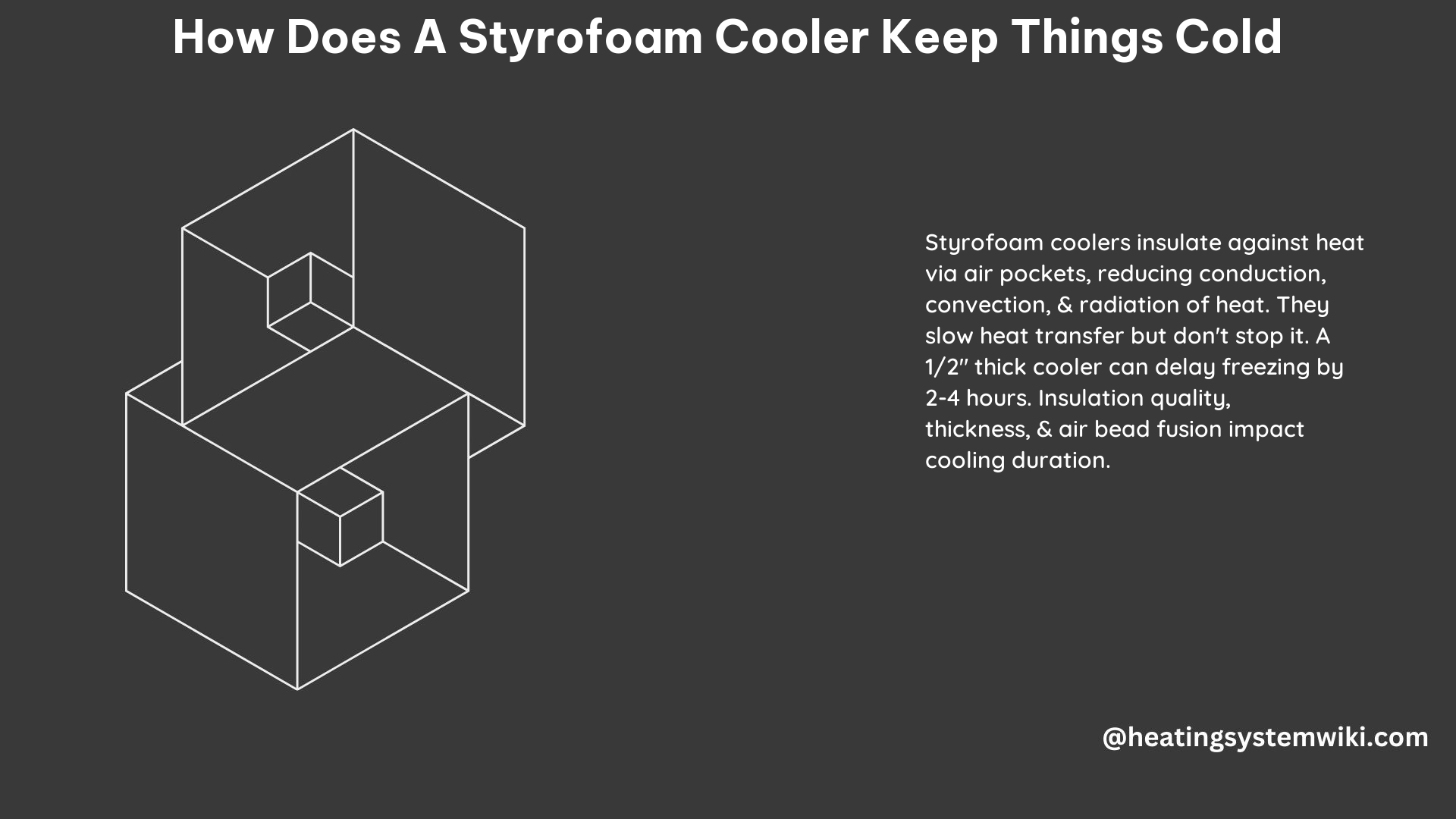Styrofoam coolers, also known as polystyrene foam coolers, are a popular choice for keeping items cold due to their excellent insulating properties. These coolers work by creating a barrier that slows down the transfer of heat from the outside environment into the interior of the cooler, effectively maintaining the desired temperature for a prolonged period.
The Science Behind Styrofoam Coolers
Styrofoam is a petroleum-based plastic material that is renowned for its low thermal conductivity, which means it is a poor conductor of heat. This property is primarily due to the unique structure of Styrofoam, which is composed of small, air-filled pockets within the polystyrene material.
Thermal Conductivity of Styrofoam
The thermal conductivity of Styrofoam is approximately 0.033 W/m·K, which is significantly lower than that of other common materials, such as aluminum (237 W/m·K) or water (0.6 W/m·K). This low thermal conductivity is what makes Styrofoam an excellent insulator, as it effectively slows down the transfer of heat from the warmer outside environment to the cooler interior of the cooler.
Air Pockets in Styrofoam
The air pockets within the Styrofoam structure play a crucial role in its insulating properties. These air pockets act as barriers, preventing the rapid transfer of heat through the material. The more air pockets and the smaller their size, the better the insulating properties of the Styrofoam.
Styrofoam Density and Insulation
The density of Styrofoam is directly related to its insulating capabilities. Typically, lower-density Styrofoam (around 15-30 kg/m³) is used in coolers, as it provides better insulation compared to higher-density Styrofoam (around 30-50 kg/m³), which is more commonly used for construction applications.
Heat Transfer Mechanisms in Styrofoam Coolers
When a Styrofoam cooler is used to store cold items, such as ice or frozen goods, the heat transfer mechanisms that occur are as follows:
-
Conduction: Heat from the warmer outside environment tries to flow into the cooler through the Styrofoam walls. However, the low thermal conductivity of Styrofoam slows down this heat transfer process.
-
Convection: The air pockets within the Styrofoam limit the movement of warm air from the outside, reducing the rate of heat transfer through convection.
-
Radiation: The Styrofoam material reflects a significant portion of the radiant heat from the outside environment, further reducing the heat transfer into the cooler.
By effectively slowing down these heat transfer mechanisms, Styrofoam coolers create a cold zone within the container, allowing the stored items to maintain their desired temperature for an extended period.
Factors Affecting the Cooling Efficiency of Styrofoam Coolers

The cooling efficiency of a Styrofoam cooler is influenced by several factors, including:
-
Thickness of the Walls: Thicker Styrofoam walls provide better insulation and slower heat transfer, resulting in a longer cooling duration.
-
Quality of the Styrofoam: Higher-quality Styrofoam with smaller air pockets and a lower density typically offers superior insulating properties.
-
Size of the Cooler: Larger coolers generally maintain their internal temperature for a longer period compared to smaller ones, as they have a lower surface area-to-volume ratio.
-
Initial Temperature of the Contents: Styrofoam coolers are more effective at maintaining the temperature of already-cold items rather than cooling down warm items. Pre-chilling the contents before placing them in the cooler is recommended.
-
Ambient Temperature: The higher the ambient temperature, the faster the heat transfer into the cooler, reducing the overall cooling duration.
-
Frequency of Opening the Cooler: Each time the cooler is opened, warm air from the outside environment enters, causing a temporary temperature increase inside the cooler.
By understanding these factors, you can optimize the performance of your Styrofoam cooler and ensure that your temperature-sensitive items remain cold for the desired duration.
DIY Styrofoam Cooler for Temporary Food Storage
If you need a makeshift Styrofoam cooler for temporary food storage, you can follow these steps:
- Obtain a Styrofoam box or cooler that is large enough to hold the items you want to store.
- Line the bottom and sides of the cooler with a single layer of plastic wrap or aluminum foil to create an additional barrier against heat.
- Place the items you want to store in the cooler, ensuring they are not touching the sides or bottom of the cooler.
- Fill any empty spaces within the cooler with crumpled newspaper, bubble wrap, or additional layers of plastic wrap or aluminum foil to further insulate the items.
- Seal the cooler with the lid, ensuring a snug fit to minimize heat exchange.
- Place the cooler inside a freezer, ensuring the cooler is not touching the sides or back of the freezer to allow for adequate air circulation.
- Monitor the temperature of the items within the cooler, adjusting the freezer temperature as needed to maintain the desired temperature.
Remember, this DIY solution is best used as a temporary measure and is not a long-term solution for storing temperature-sensitive items.
Conclusion
Styrofoam coolers are effective at keeping things cold due to their excellent insulating properties, which are primarily attributed to the low thermal conductivity of the Styrofoam material and the air pockets within its structure. By understanding the science behind Styrofoam coolers and the factors that affect their cooling efficiency, you can optimize their performance and ensure that your temperature-sensitive items remain cold for the desired duration.
References:
- The Science Behind a Styrofoam Cooler: How Does It Keep Items Cool? (2018-09-20). Retrieved from https://airseacontainers.com/blog/the-science-behind-a-styrofoam-cooler/
- How Long Does a Styrofoam Cooler Keep Ice? – YouTube (2020-07-27). Retrieved from https://www.youtube.com/watch?v=5AUKRiUi8gc
- If I put a styrofoam box and put it inside a freezer keep whatever product inside the box cool without freezing? (2023-07-18). Retrieved from https://www.reddit.com/r/questions/comments/1539v1l/if_i_put_a_styrofoam_box_and_put_it_inside_a/
- How Does a Styrofoam Cooler Keep Things Cold? – Sciencing (2018-04-27). Retrieved from https://sciencing.com/styrofoam-cooler-keep-things-cold-18521.html
- How LoBoy Styrofoam Coolers Keep Things Cold for Days! (2020-04-15). Retrieved from https://loboy.com/best-styrofoam-coolers/how-loboy-styrofoam-coolers-keep-things-cold-for-days/
